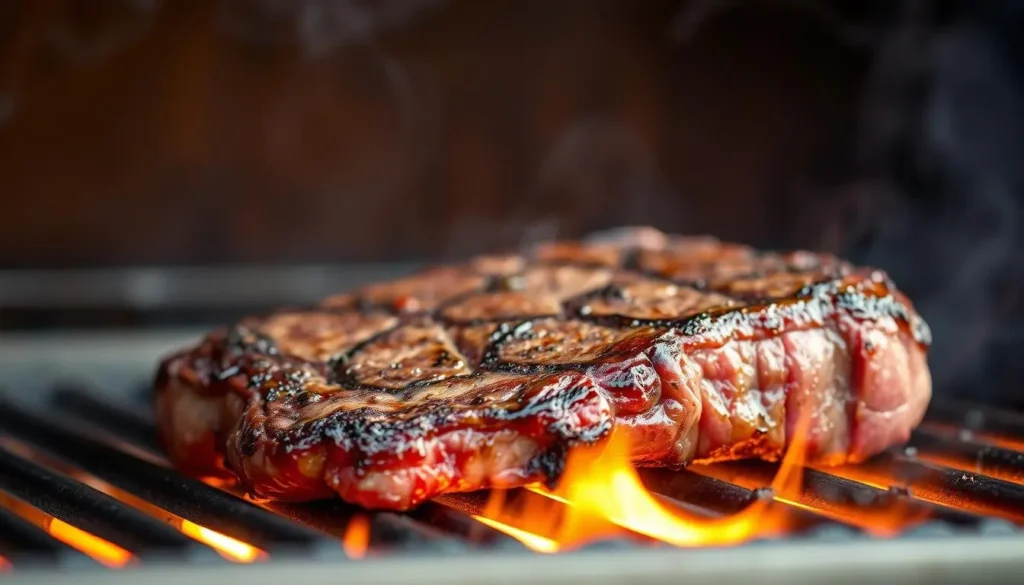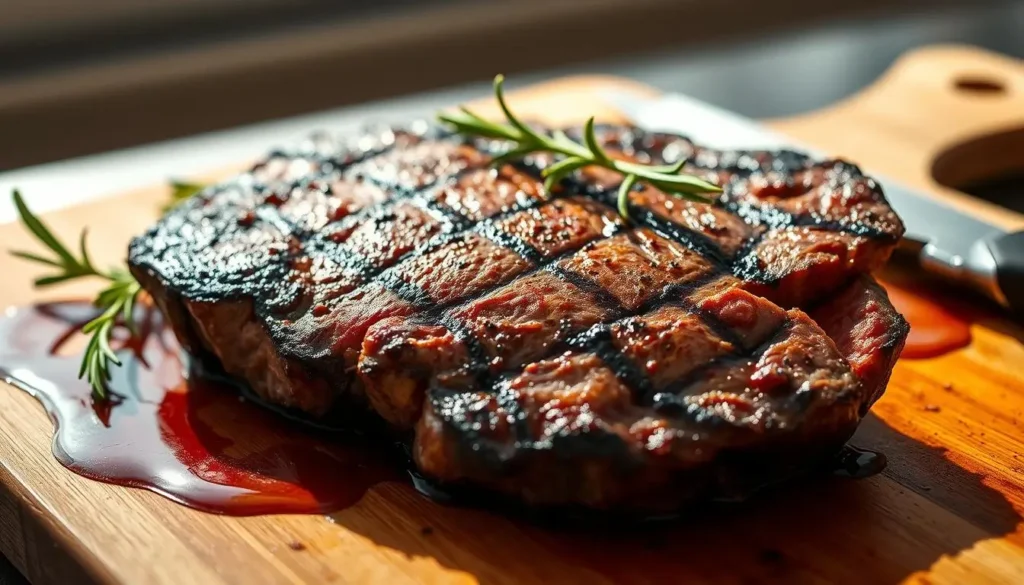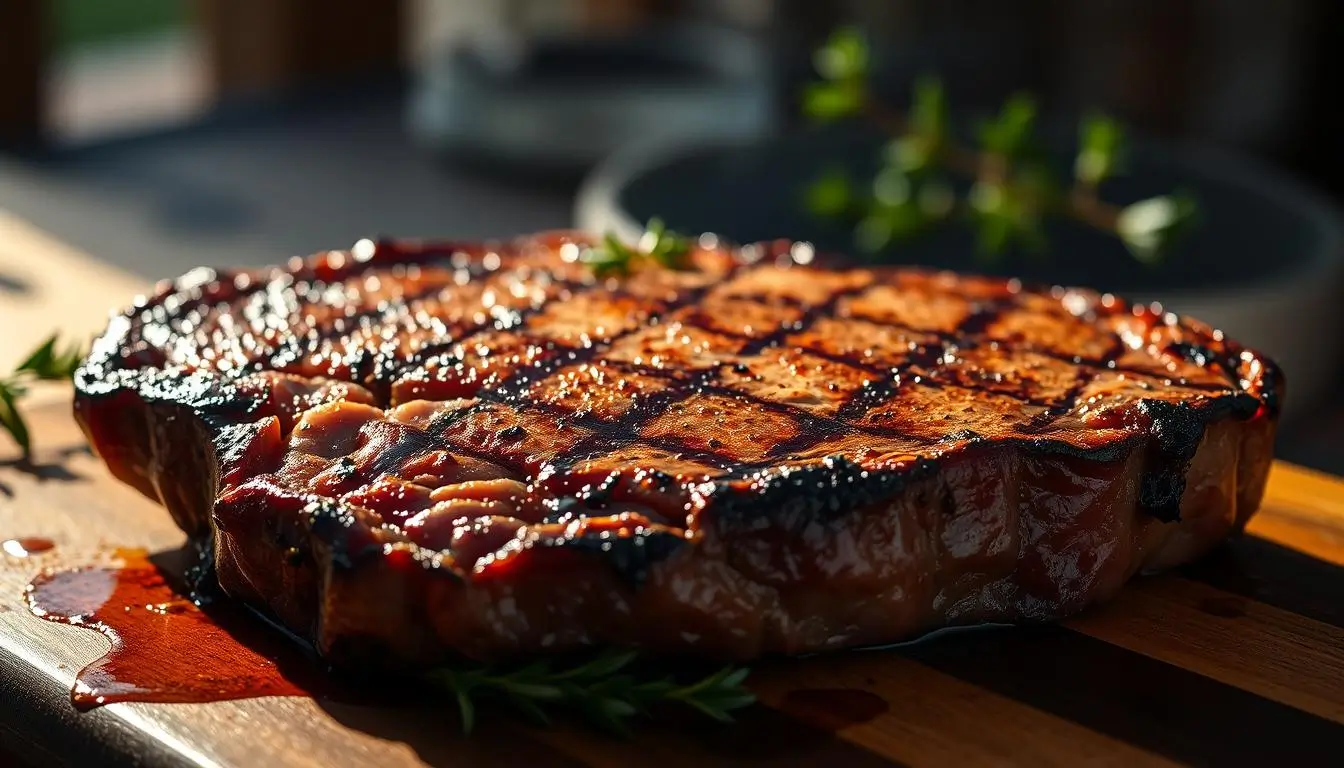A perfectly grilled ribeye steak is a true culinary delight. It can make any meal special. Its rich flavor and tender texture make it a favorite among steak lovers.
To get a perfectly grilled ribeye, you need to know its secrets. The marbling in a ribeye steak is what makes it so flavorful and tender. This makes it perfect for grilling.
Table of Contents
Understanding Ribeye Steak: What Makes It Special
Learning about ribeye steak is key to grilling it perfectly. Knowing its special qualities helps bring out its flavor and tenderness.

Characteristics of a Quality Ribeye Cut
A top ribeye cut has lots of marbling. This is the fat inside the meat. It makes the steak tender and tasty. When picking a ribeye, look for one with the right mix of fat and meat.
Why Ribeye Is Ideal for Grilling
Ribeye steak is great for grilling because of its fat. This fat keeps the meat moist, even when it’s hot. The fat also adds to the flavor, making it a hit with steak lovers. To grill a ribeye well, you need to know how to handle it.
USDA Grades and What They Mean for Flavor
The USDA grades beef, with Prime being the highest. Prime cuts have the highest marbling, with Choice and Select following in that order. For a tastier ribeye, choose Prime or Choice. These grades are more tender and flavorful because of their marbling.
Bone-in vs. Boneless Ribeye Considerations
Choosing between bone-in and boneless ribeye depends on what you like and how you grill. Bone-in steaks can taste better because the bone keeps the meat warm. Boneless steaks are easier to cook evenly. For grilling advice, think about what each type offers and pick what suits you best.
Essential Preparation Steps Before You Grill
The secret to a mouth-watering ribeye lies in the preparation before it hits the grill. To achieve a delicious ribeye steak on the grill, focus on several key steps. These steps ensure your steak is cooked to perfection.
Selecting the Perfect Ribeye at the Butcher
When choosing a ribeye, look for a cut that is at least 1 inch thick. It should have good marbling. Marbling, the white flecks of fat, makes the steak tender and flavorful.
Bringing Your Steak to Room Temperature
Before grilling, bring your steak to room temperature. This ensures even cooking. Take the steak out of the refrigerator and allow it to rest at room temperature for 30 to 45 minutes before placing it on the grill.
Seasoning Options for Maximum Flavor
Seasoning is key to enhancing your ribeye’s flavor. You have many options, from simple to complex.
Simple Salt and Pepper Approach
A classic method uses just salt and pepper. This lets the steak’s natural flavors shine while adding a touch of seasoning.
Dry Rubs and Marinades
For deeper flavors, try a dry rub or marinade. A dry rub is a spice mix applied to the steak’s surface. A marinade soaks the steak in seasoned liquid. Both add rich flavors to your ribeye.

Preparing Your Grill for Ribeye Success
Getting your grill to the proper temperature before cooking is essential. For a ribeye, aim for 450°F to 500°F. Clean and oil the grates to prevent sticking. This ensures a perfect sear.
- Preheat the grill to the correct temperature.
- Clean the grates to prevent sticking.
- Brush the grates with oil for a smooth sear.
By following these essential steps, you’ll grill a flavorful and tender ribeye steak.
How to Grill Ribeye Steak: Step-by-Step Technique
Grilling a ribeye steak to perfection is all about following a simple, step-by-step process. It’s about understanding the importance of heat zones, searing techniques, and timing. These steps help you achieve your desired level of doneness.
Setting Up Direct and Indirect Heat Zones
To grill a ribeye steak well, you need to set up your grill with both direct and indirect heat zones. Direct heat is for searing the steak. Indirect heat is for cooking it to your liking. This method gives you a nice crust and a juicy inside.
The Perfect Searing Technique
Searing the ribeye steak over high heat is key to keeping the juices in. Place the steak over direct heat for 2-3 minutes on each side, depending on its thickness. You’re aiming for a golden-brown crust.
Timing Guidelines for Different Doneness Levels
The cooking time changes based on how done you like your steak. Here are some guidelines:
Rare to Medium-Rare (125°F-135°F)
For a rare to medium-rare ribeye, cook it for 5-7 minutes after searing, using indirect heat. Use a thermometer to check the internal temperature.
Medium to Medium-Well (140°F-155°F)
For medium to medium-well, cook for 10-12 minutes after searing. Make sure the internal temperature is right.
Well Done (160°F+)
For well-done steaks, cook for 15-20 minutes after searing, or until the internal temperature hits 160°F or higher.
| Doneness Level | Internal Temperature | Cooking Time After Searing |
|---|---|---|
| Rare to Medium-Rare | 125°F-135°F | 5-7 minutes |
| Medium to Medium-Well | 140°F-155°F | 10-12 minutes |
| Well Done | 160°F+ | 15-20 minutes |
When and How to Flip Your Ribeye
Flipping the steak at the right time is key. Flip it once, halfway through searing, for even cooking and a uniform crust.
Testing for Doneness: Thermometer vs. Touch Method
There are two ways to check if your steak is done: a thermometer or the touch method. A thermometer gives you an exact internal temperature. The touch method involves feeling the steak; a firmer feel means it’s more done.
By following these step-by-step guidelines, you’ll master grilling a ribeye steak every time. You’ll become a pro at the grilled ribeye recipe and an expert in grilling guide techniques.
Finishing Touches for a Restaurant-Quality Ribeye
To make your grilled ribeye taste like it’s from a fancy restaurant, you need to do more than just grill it. The steps you take after grilling are key to a great dining experience.
The Critical Resting Period: Why and How Long
Letting the steak rest after grilling is very important. It makes the steak tender and flavorful. Let it rest for 5-10 minutes, depending on how thick it is. This also helps the temperature even out, so the steak is consistent in texture.
Compound Butter and Other Flavor Enhancers
Adding compound butter or other flavor enhancers can really boost your ribeye’s taste. Compound butter is made by mixing softened butter with herbs, spices, or other ingredients. You can melt it over the steak while it rests, adding more flavor. You can also use garlic, thyme, or rosemary to add depth to the steak.
Slicing Techniques for Maximum Tenderness
To make your ribeye tender, slice it against the grain. This means cutting it in the opposite direction of the muscle fibers. This helps the steak become more tender and pleasant to eat.
Perfect Pairings and Serving Suggestions
Choosing the right wine or drink and side dishes can make your meal even better. For wine, a full-bodied red like Cabernet Sauvignon or Malbec is great. For sides, try roasted vegetables, garlic mashed potatoes, or a fresh salad.
Wine and Beverage Recommendations
A rich, full-bodied red wine pairs well with the bold flavors of a grilled ribeye. If you prefer drinks, a craft beer or an Old Fashioned cocktail can also be a good choice.
Complementary Side Dishes
Choosing the right side dishes can enhance your ribeye’s flavors. Here are some ideas:
| Side Dish | Description | Flavor Profile |
|---|---|---|
| Roasted Vegetables | Seasonal vegetables roasted to perfection | Earthy, slightly caramelized |
| Garlic Mashed Potatoes | Creamy mashed potatoes infused with garlic | Rich, savory |
| Fresh Salad | Mixed greens with assorted toppings | Light, refreshing |
By focusing on these finishing touches, you can make a simple grilled ribeye into a memorable meal.
Mastering the Art of Grilling Ribeye Steak
Grilling a ribeye steak to perfection is a skill you can learn. It takes practice and paying close attention to detail. By understanding the quality of a ribeye cut, preparing it right, and grilling it correctly, you can make a steak as good as any restaurant’s.
This expert guide has taught you how to pick the best cut, bring it to room temperature, and season it for flavor. You’ve also learned how to grill it step by step. This includes setting up heat zones, searing, and checking for doneness.
To make your grilled ribeye even better, let the steak rest before slicing it thinly against the grain. Try adding compound butters or other flavor enhancers to your grilled ribeye. With these tips, you’ll soon be a ribeye grilling expert. You’ll impress everyone with your cooking skills.

